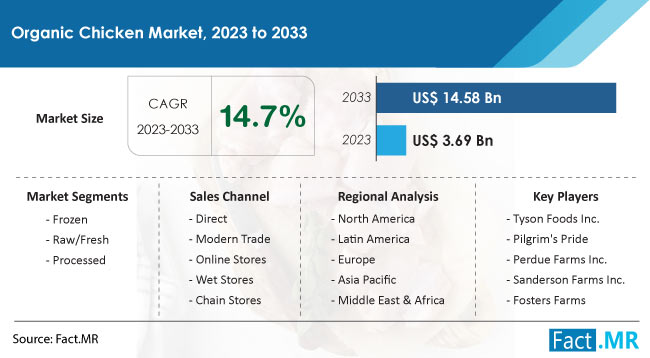Market Overview: The Organic Chicken Market has witnessed remarkable growth as consumers increasingly prioritize health-conscious food choices and sustainable agriculture. Organic chicken, raised without the use of antibiotics, synthetic pesticides, and genetically modified organisms, represents a premium and ethically produced protein source. The market caters to individuals seeking high-quality poultry products that align with their values of animal welfare, environmental sustainability, and personal well-being.
For More insights into the, Request a Sample of this Report:
https://www.factmr.com/connectus/sample?flag=S&rep_id=1554?SR
Market Trends:
- Health and Sustainability: The market is driven by consumers’ focus on health and sustainability, leading them to opt for organic chicken due to its perceived benefits for human health and reduced environmental impact.
- Transparency and Traceability: Consumers are demanding transparency in food production processes. Brands offering organic chicken often emphasize traceability, providing information about the chicken’s origin and production practices.
- Local Sourcing: The trend of supporting local producers and reducing food miles contributes to the growth of regional and local organic chicken markets.
- Premium Convenience: Brands are offering ready-to-cook and value-added organic chicken products, catering to consumers seeking convenience without compromising on quality.
Competitive Analysis: The Organic Chicken Market features a mix of established poultry companies and specialized organic brands. Major players in the poultry industry, such as Perdue Farms and Tyson Foods, have introduced organic chicken lines to meet the rising demand for organic products.
Specialized organic brands like Bell & Evans and Applegate focus exclusively on organic and ethically produced chicken. They often highlight their commitment to animal welfare, sustainability, and clean-label practices.
Local and regional producers play a significant role in the market, particularly in farmers’ markets and community-supported agriculture (CSA) programs. These producers often appeal to consumers seeking fresher and locally sourced organic chicken.
Regional Analysis: North America is a prominent market for organic chicken, driven by consumers’ preference for organic and natural foods. The region’s well-established organic agriculture practices and increasing awareness of food quality contribute to the market’s growth.
Europe follows suit, with stringent organic regulations and a conscious consumer base. The market here benefits from consumers’ emphasis on animal welfare and sustainable practices.
Asia-Pacific showcases potential as consumers in countries like Australia and Japan are increasingly seeking organic and premium food options. The region’s evolving dietary preferences and health consciousness contribute to the demand for organic chicken.
In Latin America and the Middle East & Africa regions, where traditional and natural farming practices are still prevalent, the organic chicken market is gradually gaining traction, albeit with unique challenges and opportunities.
In conclusion, the Organic Chicken Market resonates with health-conscious and environmentally aware consumers seeking ethically produced poultry. As brands compete to offer transparency, quality, and sustainability, the market’s trajectory is influenced by changing dietary preferences, consumer education, and the global movement toward more responsible food production.
